Finding solutions: professors and students uphold equity and inclusion in the chemistry lab
While making compounds and refining solutions, McDaniel students learn to define the role of the chemist — and find it to be limitless. Supported by Chemistry faculty in classrooms and research labs, students prepare for fulfilling careers in the sciences.
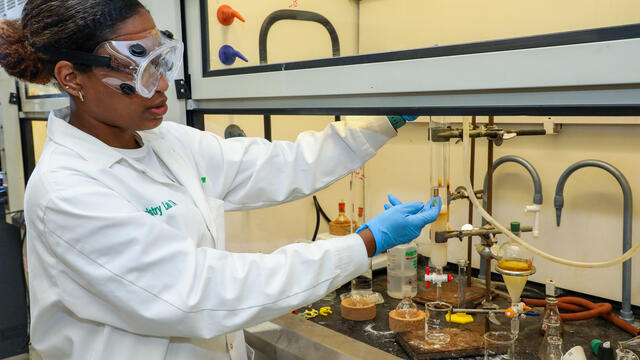
Senior Psychology major Devyn Thorne conducted a purification process for solutions in the lab of Associate Professor of Chemistry Dana Ferraris in the Student-Faculty Collaborative Summer Research Program.
Forming Bonds in the Lab
When you ask a McDaniel student what people think of the typical chemist, they’ll give a range of stereotypes they’ve encountered, like someone “who only makes different compounds and chemicals” or works with “interesting-colored liquids heating within a lab,” “a nerdy old guy with no friends,” “white scientists,” and a role that’s “male-dominated and rather daunting for women to integrate themselves into.”
But McDaniel students are not content to let the typical image of a chemist go unchallenged. From redefining the type of work people assume is done in a lab — “I would like to see it change because the discipline of chemistry is extremely vast, and scientists can work with lots of different material, including biological,” says senior Matthew Tachoute — to the people doing it: “I would love to see more women enter the field and alter the public’s perception of what a chemist looks like,” says sophomore Shannon Short.
Lab experience imparts vital skills for future employment and further education in the sciences, so it is not taken lightly by McDaniel professors, especially if a student has never been in a lab before arriving at McDaniel.
With these goals in mind, McDaniel professors and students are working together in the lab to make discoveries, and while doing so, create an accessible and welcoming environment for all.
“We increasingly work with more diverse groups of student researchers to demonstrate that they can do it as well as anybody when given the opportunity,” says Peter Craig, associate professor of Chemistry.

Falarunu made compounds for the Craig lab's control study.
This summer, the science labs in Eaton Hall bustled with the activity of 19 student researchers, who represented a wide array of backgrounds and subject interests, generating innovation.
Students in Craig’s chemistry lab make, identify, and study cobalt and zinc Schiff-base probes and antivirals in ongoing research that can contribute to the development of life-saving pharmaceuticals. The students work on individual tasks but contribute to a central project.
“Because you need lab experience if you want to work in the field of science, the accessibility of STEM education at McDaniel is important for students of all backgrounds,” says Health Sciences major Bidemi Falarunu.
During lab research, Craig says, the students can improve their skills and develop confidence in new situations, preparing them for fruitful future careers.
“They can then graduate from McDaniel to be insightful employees or graduate students based on this research experience, even if inequities did not set them up this way at the onset of their studies,” he says.
The students — who are enrolled in many different major and minor programs — learn that collaboration is a core element of research and common in STEM professions. In his own career, Dana Ferraris, associate professor and Chemistry department chair, has collaborated on an international scale.
“Having people on your team from many different places and backgrounds allows you to think outside of the box and come to conclusions you might not have otherwise found.”
“Major discoveries are not made in a vacuum,” Ferraris says. “Having people on your team from many different places and backgrounds allows you to think outside of the box and come to conclusions you might not have otherwise found.”
The students in his lab continued the work of previous years in the design, synthesis, and evaluation of inhibitors of the SARS-CoV2 macrodomain as potential antivirals.
“Dr. Ferraris likes to make both his lab and office feel like a second home,” says junior Kathryn Stachowiak, a Chemistry major with a minor in Secondary Education. “He helps you gain independence and build confidence, because he knows this stuff is hard and we’re new to it. I left that lab a whole new chemist.”
Stachowiak, who plans to become a chemistry teacher in the future, especially valued the collaboration of lab research with Ferraris — which included having some fun.
“Even though we were all doing slightly different things, we helped each other the best we could. We also played music and cracked jokes while generating almost 100 new compounds by the time summer was over,” she says. “I learned so many new skills and refined ones I already had, building my confidence in the field.”
“McDaniel has put a lot of effort into supporting women in STEM and it shows,” says senior Madison Facine, who worked in Ferraris’ lab. “I never once felt in the minority of my peers here on the Hill in any lab setting.”
Facine, who is a Health Sciences major minoring in Chemistry and Art, added, “I feel extremely welcome and encouraged by other students and faculty to pursue my career and education in chemistry. I would like to see this mentality in other colleges. It has become a standard I will look for in any future employer as well any higher education facility.”
“McDaniel has put a lot of effort into supporting women in STEM and it shows."
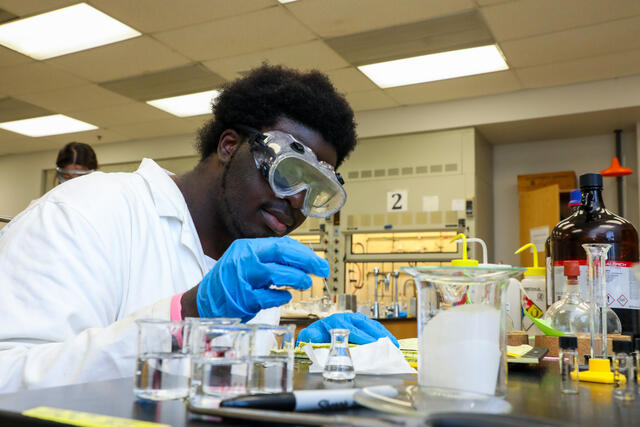
Tachoute conducted TLC characterizations in the Ferraris lab.
Matthew Tachoute, a senior Psychology and Biomedical Sciences dual major with a minor in Chemistry, says, “I think the accessibility of STEM education at McDaniel is important for students of all backgrounds in order to incorporate fundamental skills like analyzing and manipulating data, and the overall logistics of hard science that can be applied in the real world.
“It further increases the well-roundedness that should be achieved within a liberal arts education,” he added. “Since I’m a first-generation student, I continue to appreciate my place within this school and hope it takes me further.”
Modeling the Future
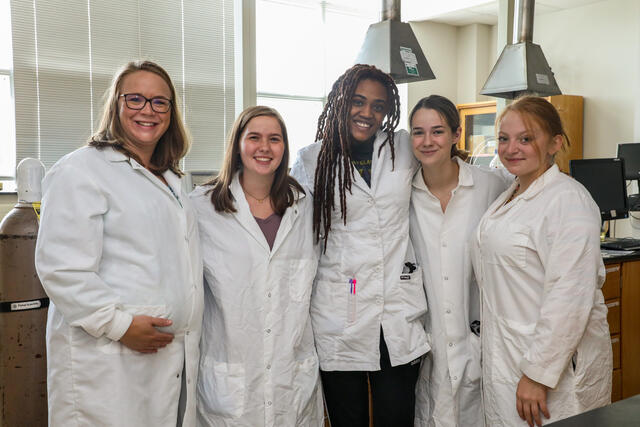
Homan with Hailey Perry, Makela Brown, Shannon Short, and Lauren Guyer (l-r).
Like the labs of Ferraris and Craig, Assistant Professor of Chemistry Stephanie Homan’s lab is an inclusive environment geared toward discovery. Her students explored the biocompatibility of quantum dot nanocrystals (commonly used in the screens of QLED TVs) by creating their own.
Quantum dots are 10,000 times smaller than a grain of sand, confining the electrons within them in a way that causes them to emit color when exposed to light.
This fluorescence can be useful in biomedical imaging, but to make them safe for use in the human body, three students — Shannon Short, Lauren Guyer, and Makela Brown — coated them in non-toxic zinc.
“You can truly bring any idea to the table and your faculty member will provide you with the appropriate guidance to bring your ideas to fruition,” says Short, who is a sophomore Biomedical Sciences major minoring in Chemistry.
A first-generation student, Short says her time at McDaniel is an opportunity to “grow into the person and student I’ve always wanted to become.
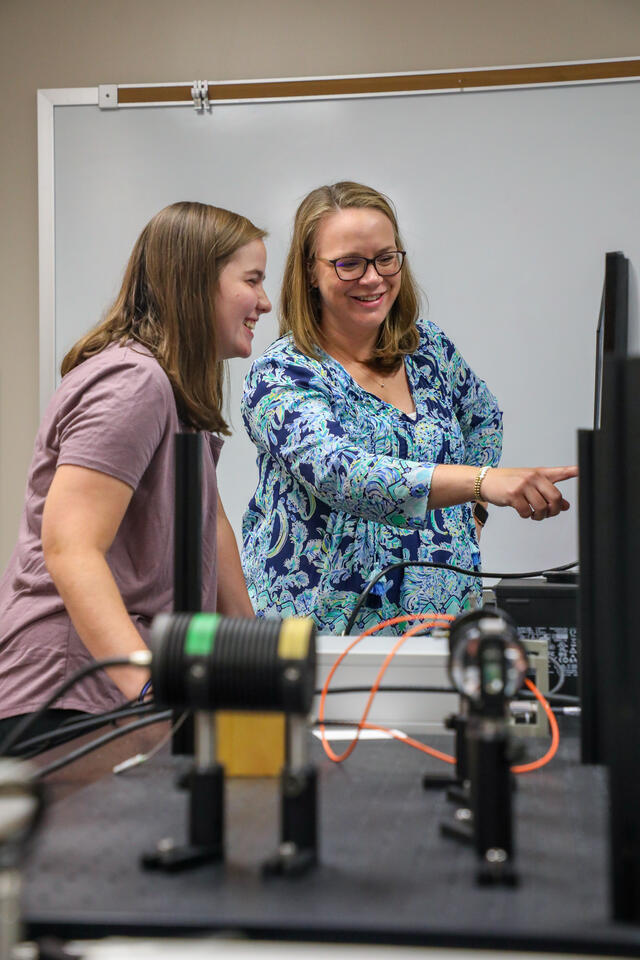
Perry (l) looks at images from her laser experiments with Homan (r).
“I had only taken General Chemistry up to this point. Yet, as the weeks progressed, I stopped second-guessing myself and overthinking my choices as my confidence and abilities grew,” she says. “The confidence that was ignited within me this summer is something I’m thankful I can carry forward with me.”
A fourth student in the lab, Hailey Perry, built a time-resolved laser instrument in the spring and summer of 2022 that provides a unique way to see how effectively the electrons in the quantum dots were absorbing and emitting light. One quantum dot may dim faster than another, which would make it a less useful candidate.
Perry, who is a Chemistry major minoring in Secondary Education, plans to become a teacher and hopes to see the field of STEM become “more diverse and more accepting of women in chemistry careers.”
Lauren Guyer, a Biology major with minors in Psychology and Chemistry, says she appreciates how teamwork in the lab, and the inclusion of many perspectives, can make research more generative.
“Accessibility to STEM education for all is important because with diverse people come diverse ideas, which opens the door for a whole new level of collaboration,” says Guyer.
“While my experience in the lab this summer has been full of opportunity, it’s important to understand that plenty of work still needs to be done on a larger scale to change society’s perception of who exactly ‘belongs’ in STEM — because anyone should be able to belong,” she added.
"Plenty of work still needs to be done on a larger scale to change society’s perception of who exactly ‘belongs’ in STEM — because anyone should be able to belong."
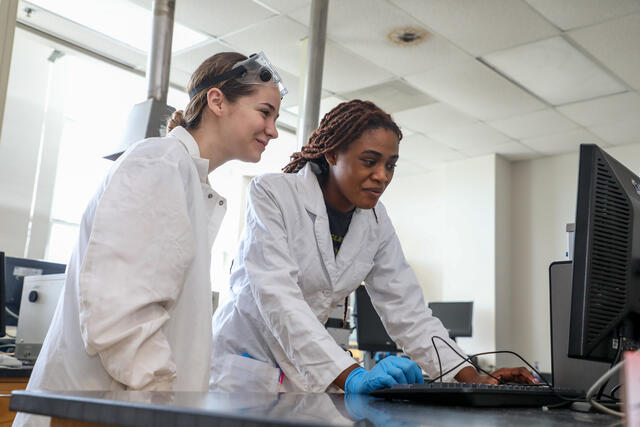
Short (l) and Brown (r) worked together to examine experiment outcomes.
Another one of the benefits of research, Homan says, is how it introduces students to what a career in a lab would entail and models what an effective lab looks like.
“The students are in the lab working as chemists, focused on one problem and thinking critically about how to solve it,” she says. “They’re getting so much more experience than ever before, which increases their confidence.”
Homan’s own history with working in labs has not always involved inclusive environments, which has inspired her to make the McDaniel labs a place for every student.
“When I was in graduate school and as a postdoc, I was one of the only women in my lab, which is not a reflection of the population in undergraduate classes. This summer, for the first time, I had all female scientists working in my lab!” Homan says. “My hope is to set the students up to be successful and confident as they’re going into industry or graduate schools.”
Guyer, who has plans to attend graduate school for genetic counseling, says that her favorite aspect of working with Homan was “how she serves as a role model for me as a successful woman in STEM who is also an educator, mother, and wife. It is inspiring to see that I could potentially have it all, too!”


